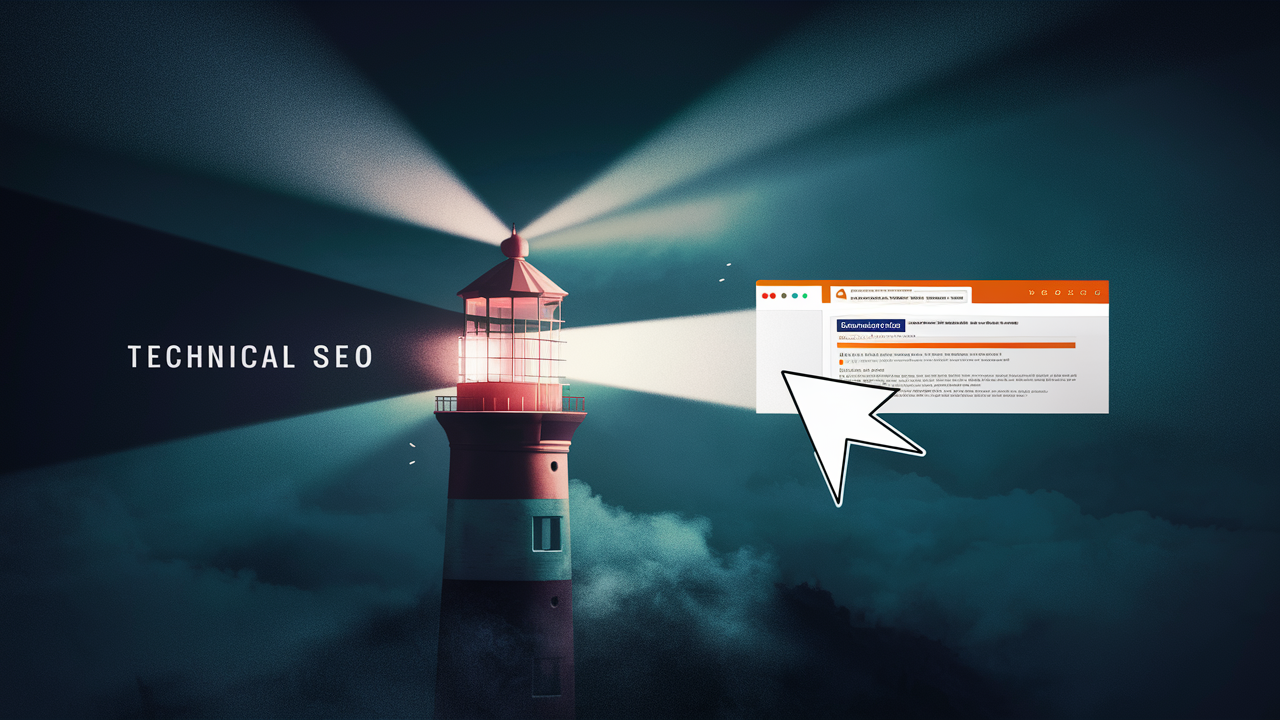
Crack the Code: Your Essential Guide to Mastering Technical SEO
- fyerx
- May 2, 2024
- Blog
- Digital marketing, ecommerce seo, Marketing, seo, technical seo
- 0 Comments
Have you ever poured your heart and soul into creating amazing content, only to see it languishing in the depths of search engine results pages (SERPs)? Trust me, you’re not alone. While compelling content is crucial, there’s a hidden force working behind the scenes to ensure your website gets noticed by search engines – technical SEO.
This guide dives deep into the fascinating world of technical SEO, unraveling its mysteries and empowering you to optimize your website for search engine success. Whether you’re a seasoned marketer or a complete beginner, this comprehensive breakdown will equip you with the knowledge and tools to take your website to the top.
What is Technical SEO, and Why Should You Care?

Imagine a vast library with millions of books. Search engines are like librarians, constantly crawling through shelves (websites) to categorize and index information. Technical SEO ensures your website’s structure and content are clear, organized, and easily understood by these “librarians,” making it more likely your website appears in relevant search results.
Think of it this way: a well-organized website with clear pathways is easier to navigate, both for search engines and users. Technical SEO focuses on optimizing these “pathways” to ensure a smooth and efficient experience for everyone.
Benefits of Stellar Technical SEO:
- Higher Search Engine Rankings: By making your website more search engine friendly, you increase your chances of appearing on the first page of SERPs, where the majority of clicks happen.
- Increased Organic Traffic: Improved rankings translate to more visitors finding your website organically, boosting your brand awareness and potential leads.
- Enhanced User Experience: Technical SEO often overlaps with user experience (UX) best practices. A website that’s easy for search engines to crawl is often easier for users to navigate and interact with.
- Improved Conversion Rates: When users have a seamless experience on your website, they’re more likely to convert, whether it’s making a purchase, subscribing to your newsletter, or contacting you.
Core Technical SEO Factors: Building a Strong Foundation

Now that you understand the power of technical SEO, let’s delve into the key factors that contribute to a solid foundation.
1. Website Crawlability: Making Sure Search Engines Can Find You
Think of search engine crawlers as little robots that scour the internet, following links and indexing websites. To be indexed, your website needs to be easily crawlable. Here’s how to ensure smooth crawling:
- Website Architecture: Imagine your website as a house. A well-organized house with clearly labeled rooms is easier to navigate than a maze. Similarly, a clean and logical website architecture with clear navigation paths makes it easier for crawlers to find and understand your content.
Tips:
- Maintain a flat website structure, ideally no more than 3 clicks deep from the homepage to any other page.
- Use clear and descriptive category and page names that reflect the content.
- Employ breadcrumbs to help users and crawlers understand their location within the website structure.
- Robots.txt: This file acts as a set of instructions for search engine crawlers, telling them which parts of your website they can access and which to avoid. Use robots.txt strategically to prevent crawlers from indexing irrelevant pages, like login pages or internal search results.
Tips:
- Use a robots.txt tester tool to ensure your robots.txt file is functioning correctly.
- Disallow crawling of temporary pages or pages under development to avoid confusing search engines.
- Sitemap: A sitemap is like a map of your website, listing all the important pages and their relationships. Submitting a sitemap to search engines helps them discover and index your content more efficiently.
Tips:
- Create separate sitemaps for different content types (e.g., blog posts, product pages).
- Submit your sitemap to Google Search Console and other major search engines.
- Update your sitemap regularly whenever you add or remove new pages from your website.
2. Website Indexability: Helping Search Engines Understand Your Content
Crawlability gets your website noticed, but indexability allows search engines to understand what your website is about. Here’s how to optimize indexability:
- Meta Tags: These are snippets of code embedded in your website’s head section. They include the title tag, which appears in search results, and the meta description, a brief summary displayed below the title. Writing clear, concise, and keyword-rich meta tags helps search engines understand the content of your pages and determine their relevance to user searches.
Tips:
- Keep title tags under 60 characters and meta descriptions under 160 characters for optimal display in search results.
- Include your target keywords naturally within the title tag and meta description, but avoid keyword stuffing.
- Write compelling meta descriptions that entice users to click on your website in search results.
3. Website Health: Smooth User Experience
Technical SEO isn’t just about pleasing search engines; it’s also about creating a positive user experience. Here are some factors that contribute to a healthy website:
- Mobile-friendliness: In today’s mobile-first world, search engines prioritize websites that offer a seamless experience on all devices. Ensure your website is responsive and adapts to different screen sizes.
Tips:
- Use a responsive web design (RWD) framework to ensure your website adjusts automatically for different devices.
- Test your website’s mobile-friendliness using Google’s Mobile-Friendly Test tool: https://developers.google.com/search/blog/2016/05/a-new-mobile-friendly-testing-tool
- Page Speed: Nobody likes a slow website. Search engines penalize slow-loading pages, hurting your rankings and frustrating users. Optimize page speed by using image compression techniques, caching, and optimizing server response time.
Tips:
- Use tools like Google PageSpeed Insights to identify areas for improvement in your website’s loading speed: https://developers.google.com/speed/docs/insights/v5/about
- Optimize image sizes by compressing them without sacrificing quality.
- Consider using a Content Delivery Network (CDN) to improve page load times for users in different locations.
- Broken Links: Imagine a website filled with dead ends. Broken links not only frustrate users but also indicate a poorly maintained website. Use tools like Google Search Console to identify and fix broken links regularly.
Tips:
- Regularly check your website for broken links using a broken link checker tool.
- Redirect broken links to the most relevant existing page on your website whenever possible.
- Remove broken links that no longer point to relevant content.
Once you’ve mastered the core technical SEO factors, you can explore advanced techniques to further optimize your website.
1. Structured Data (Schema Markup): Speaking the Search Engine Language

Structured data, also known as schema markup, is a way to provide search engines with additional information about your content in a way they can easily understand. Think of it as adding labels to your website content, making it more informative and visually appealing in search results. Here’s how schema markup benefits your SEO:
- Rich Snippets: By implementing schema markup, you increase your chances of your website appearing in rich snippets on SERPs. Rich snippets can include additional information like product ratings, event details, or author information, making your listing stand out and attracting more clicks.
- Improved Search Relevance: Schema markup helps search engines understand the context of your content more accurately, leading to better matching with relevant search queries.
Tips:
- Identify the most relevant schema markup types for your website content (e.g., product schema for e-commerce websites, recipe schema for food blogs).
- Use Google’s Search Console Schema Markup Helper tool to easily generate schema markup code for your website: [invalid URL removed]
- Validate your schema markup implementation using Google’s Rich Results Test tool: https://search.google.com/test/rich-results
2. International SEO: Reaching a Global Audience

If you’re targeting an international audience, here are some technical SEO considerations:
- Hreflang Tags: These tags tell search engines which language version of your website is most relevant for users in a specific location. Proper use of hreflang tags ensures users see the most relevant version of your website based on their language preference.
Tips:
- Implement hreflang tags correctly on all language versions of your website.
- Use a language code (e.g., en-US for US English, fr-FR for French) to specify the language of each webpage.
- Test your hreflang implementation using Google Search Console’s International Targeting report.
3. Technical SEO Audits: Identifying Areas for Improvement

Regular technical SEO audits are essential for maintaining a healthy website. Think of it as a checkup for your website’s health. An audit helps you identify potential issues affecting your crawl budget, indexability, or overall user experience.
Here are some key elements to consider during a technical SEO audit:
- Crawl errors: Identify and fix any crawl errors that might be preventing search engines from accessing your pages.
- Mobile-friendliness: Evaluate your website’s responsiveness and mobile user experience.
- Page speed: Analyze page load times and identify areas for improvement.
- Broken links: Find and fix any broken links that could be hindering user experience and SEO performance.
Tips:
- Conduct technical SEO audits regularly, ideally every few months.
- Leverage free and paid SEO audit tools to streamline the process.
- Prioritize fixing critical errors that can significantly impact your website’s SEO performance.
- Track your progress and measure the impact of SEO improvements over time.
Several free and paid tools can help you conduct a technical SEO audit. Google Search Console is a valuable resource that offers insights into website crawl errors, mobile usability, and more.

Remember: Technical SEO is an ongoing process. As search engine algorithms evolve and user expectations change, staying up-to-date with the latest best practices is crucial.
Conclusion:
By implementing the strategies outlined in this guide, you can transform your website into a well-oiled machine, optimized for both search engines and users. Remember, technical SEO is a journey, not a destination. As you continue to learn, experiment, and refine your approach, you’ll witness the power of technical SEO in propelling your website to the top of search results and attracting a loyal audience.
Contact the seo agency in bangalore for hassle-less process of technical seo optimization.
Related Posts

- fyerx
- October 18, 2023
Zudio’s Remarkable Success in Indian Fashion Industry with Zero Marketing
Zudio’s Remarkable Success in Indian Fashion Industry In the world of Indian fashion, one ..

- fyerx
- June 13, 2022
What Is the Marketing Funnel and How Does It Work?
Table of contents Stages of the Marketing Funnel Four Main Marketing Funnel Strategies Four Mar ..




Recent Comments